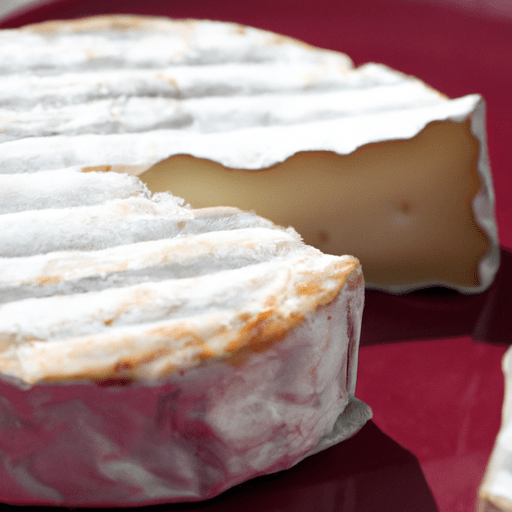Exploring the Creamy Delights of Camembert Cheese
If you’re a cheese lover, then you’re in for a treat today. Let’s dive into the world of Camembert cheese, a creamy and delicious cheese that has captured the hearts and taste buds of many around the globe. In this blog post, we’ll explore the tantalizing taste of Camembert, its versatile uses in cooking, its nutritional value, and some fascinating historical facts. So, grab a slice of crusty bread and get ready to savor the rich flavors of this iconic cheese.
Taste Sensations
Camembert cheese is renowned for its unique and distinctive taste. Made from cow’s milk, this soft-ripened cheese boasts a rich, creamy texture that oozes when perfectly ripe. Beneath its bloomy white rind lies a velvety, buttery interior with earthy and slightly tangy flavors. The cheese matures from the outside in, resulting in a creamy center and a slightly firmer outer layer. When aged to perfection, it offers a heavenly balance of flavors that is both creamy and savory, making it an absolute delight for your taste buds.
Culinary Versatility
Camembert cheese’s versatility in the kitchen is commendable. It adds a touch of luxury and indulgence to both simple and elaborate dishes. Here are a few delicious ways to incorporate Camembert into your culinary creations:
Baked Camembert: Indulge in the ultimate comfort food by baking a whole round of Camembert until it becomes soft and gooey. Serve it warm with fresh bread, crackers, or fruits for a crowd-pleasing appetizer.
Camembert Fondue: Melted Camembert mixed with white wine and garlic creates a delightful fondue. Pair it with crusty bread, blanched vegetables, or cured meats to enjoy a communal dining experience with family and friends.
Camembert Salad: Add slices or chunks of Camembert to a fresh green salad for a creamy and tangy twist. The cheese complements the vibrant flavors of fruits like pears, apples, or grapes, creating a salad that’s both refreshing and satisfying.
Camembert Topping: Elevate your favorite burgers or grilled sandwiches by melting Camembert on top. Its rich and creamy nature adds a luxurious element that takes your dish to a whole new level of deliciousness.
Nutritional Value
While Camembert cheese is undoubtedly indulgent, it also offers some nutritional benefits. Here’s a breakdown of its approximate nutritional value per 100g serving:
- Calories: 299
- Protein: 20g
- Fat: 24g
- Saturated Fat: 15g
- Carbohydrates: 0.5g
- Calcium: 200mg
- Sodium: 510mg
Camembert cheese is a good source of protein and calcium. However, it should be enjoyed in moderation due to its high saturated fat content.
Historical Significance
The history of Camembert cheese is as captivating as its taste. It originated in the late 18th century in the picturesque region of Normandy, France. Legend has it that a local farmer named Marie Harel developed the recipe after learning it from a priest fleeing the French Revolution. This soft-ripened cheese gained popularity over the years, and by the late 19th century, it had become an iconic symbol of French gastronomy.
Fun Facts
To keep the conversation lively, here are some intriguing facts about Camembert cheese:
- Protected Designation of Origin (PDO): Since 1983, true Camembert cheese can only be produced in specific regions of Normandy using unpasteurized milk. This restriction ensures the authenticity and quality of this beloved cheese.
- Artistic Inspiration: Camembert cheese has been a muse for artists, including the famous painter Claude Monet. He created a series of still-life paintings featuring the cheese, immortalizing its beauty through his art.
- World Camembert Day: March 30th is dedicated to celebrating Camembert cheese worldwide. It’s the perfect opportunity to gather friends and family to enjoy this tantalizing cheese.
Now that you’ve delved into the captivating world of Camembert cheese, it’s time to indulge in its creamy goodness. Whether you savor it on its own, bake it to perfection, or incorporate it into innovative recipes, Camembert is sure to delight your taste buds. So, grab a piece, and let the creamy and tangy flavors transport you to the enchanting countryside of Normandy, where this iconic cheese was born. Bon appétit!
Note: Nutritional values are approximate and may vary depending on the specific cheese brand and ripeness.
Camembert Cheese
Origin: Camembert cheese originated in the Normandy region of France. It was first made by Marie Harel, a French farmer, in the late 18th century. The cheese gained popularity and eventually became a symbol of French gastronomy.
Common Uses: Camembert cheese is most commonly enjoyed on its own with bread or crackers. It has a creamy texture and a strong, earthy flavor. It is also popular in cooking, where it can be used in dishes such as baked camembert, salads, soups, and pastas.
Nutritional Benefits: Camembert cheese is a good source of several important nutrients. It is rich in protein, calcium, and vitamin B12. However, it is also high in saturated fat and sodium, so it should be consumed in moderation as part of a balanced diet.
Unique Properties: One of the unique properties of camembert cheese is its characteristic rind. The rind is made of white mold, which develops during the cheese-making process. The mold helps to give the cheese its distinct flavor and texture. It also acts as a natural preservative, allowing the cheese to mature and develop its flavors over time.
Historical Significance: Camembert cheese holds a special place in French history and culture. During World War I, camembert was sent to French soldiers on the front lines to boost their morale. The cheese also gained international recognition when it was featured in the French pavilion at the 1878 Paris World Exposition. Today, camembert is known and enjoyed worldwide as an iconic French cheese.




Use the share button below if you liked it.
It makes me smile, when I see it.